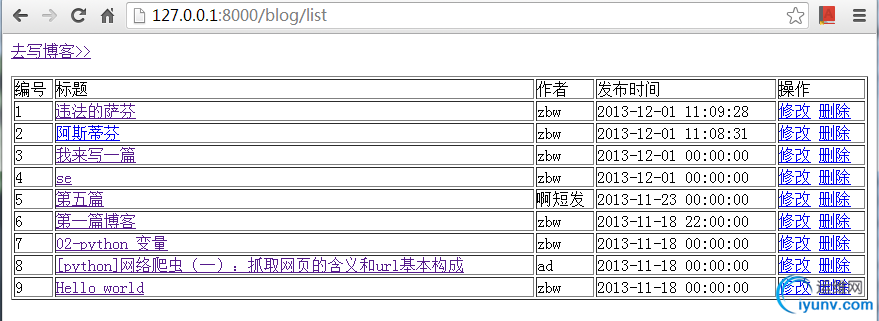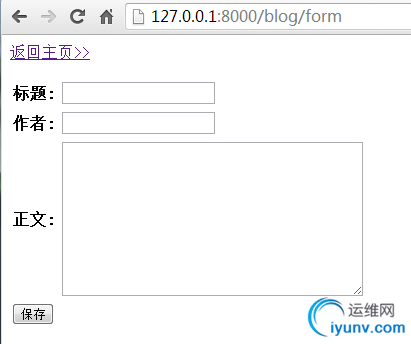|
|
简单效果图


1,创建一个项目myblog 可参考这里
myblog/
manage.py
myblog/
__init__.py
settings.py
urls.py
wsgi.py
2,创建blogs app 可参考这里
myblog/myblog/blogs/
__init__.py
models.py
tests.py
views.py
#vim: set fileencoding=utf-8:
from django.db import models
# Create your models here.
class Blog(models.Model):
title = models.CharField(u'标题', max_length=50)
author = models.CharField(u'作者', max_length=10)
content = models.CharField(u'正文', max_length=2000)
post_date = models.DateTimeField(u'发布时间',auto_now_add=True)
class Meta:
ordering = ['-post_date']
import os.path #加载模版需要导入库
#数据库连接
DATABASES = {
'default': {
'ENGINE': 'django.db.backends.mysql', # Add 'postgresql_psycopg2', 'mysql', 'sqlite3' or 'oracle'.
'NAME': 'myblog', # Or path to database file if using sqlite3.
# The following settings are not used with sqlite3:
'USER': 'root',
'PASSWORD': 'root',
'HOST': '127.0.0.1', # Empty for localhost through domain sockets or '127.0.0.1' for localhost through TCP.
'PORT': '3306', # Set to empty string for default.
}
}
#模型安装
INSTALLED_APPS = (
'django.contrib.auth',
'django.contrib.contenttypes',
'django.contrib.sessions',
'django.contrib.sites',
'django.contrib.messages',
'django.contrib.staticfiles',
# Uncomment the next line to enable the admin:
'django.contrib.admin',
'myblog.blogs',
# Uncomment the next line to enable admin documentation:
# 'django.contrib.admindocs',
)
#加载模版
TEMPLATE_DIRS = (
# Put strings here, like "/home/html/django_templates" or "C:/www/django/templates".
# Always use forward slashes, even on Windows.
# Don't forget to use absolute paths, not relative paths.
os.path.join(os.path.dirname(__file__), 'templates').replace('\\','/'),
)
MIDDLEWARE_CLASSES = (
'django.middleware.common.CommonMiddleware',
'django.contrib.sessions.middleware.SessionMiddleware',
'django.middleware.csrf.CsrfViewMiddleware', #csrf防御,post提交跨站请求伪造
'django.contrib.auth.middleware.AuthenticationMiddleware',
'django.contrib.messages.middleware.MessageMiddleware',
# Uncomment the next line for simple clickjacking protection:
# 'django.middleware.clickjacking.XFrameOptionsMiddleware',
)
#settings.py基本修改就这些了
- 采用 python manage.py validate 检查模型的语法和逻辑是否正确。
没有错误则执行 python manage.py syncdb创建数据表。
3,编写forms.py
myblog/myblog/forms.py
#vim: set fileencoding=utf-8:
from django import forms
class BlogForm(forms.Form):
title = forms.CharField(label='标题')
author = forms.CharField(label='作者')
content = forms.CharField(label='正文',widget=forms.Textarea)
4,编写views.py
myblog/myblog/views.py
#vim: set fileencoding=utf-8:
from django.http import HttpResponseRedirect
from django.shortcuts import render_to_response
from myblog.blogs.models import Blog
from myblog import forms
from django.template import RequestContext
def blog_list(request):
blog_list = Blog.objects.all()
return render_to_response('blog_list.html',{'blog_list':blog_list})
def blog_form(request):
if request.method == 'POST':
form = forms.BlogForm(request.POST)
if form.is_valid():
data = form.cleaned_data
if 'id' not in data:
blog = Blog(title=data['title'],author=data['author'],content=data['content'])
blog.save()
else:
blog = Blog.object.get(id=data.id)
blog.title = data['title']
blog.author = data['author']
blog.content = data['content']
blog.save()
return HttpResponseRedirect('/blog/list')
else:
form = forms.BlogForm()
return render_to_response('blog_form.html',{'form':form},context_instance=RequestContext(request))
def blog_del(request):
errors = []
if 'id' in request.GET:
bid_ = request.GET['id']
Blog.objects.filter(id=bid_).delete()
return HttpResponseRedirect('/blog/list')
else:
errors.append("参数异常请刷新后重试")
return render_to_response('blog_list.html', {'errors': errors})
def blog_view(request):
errors = []
if 'id' in request.GET:
bid_ = request.GET['id']
blog = Blog.objects.get(id=bid_)
return render_to_response('blog_view.html',{'blog':blog})
else:
errors.append("参数异常请刷新后重试")
return render_to_response("blog_list.hmtl",{'errors':errors})
def blog_edit(request):
errors = []
if 'id' in request.GET:
bid_ = request.GET['id']
blog = Blog.objects.get(id=bid_)
form = forms.BlogForm(
initial = {'id':blog.id,'title':blog.title,'author':blog.author,'content':blog.content}
)
return render_to_response('blog_form.html',{'form':form},context_instance=RequestContext(request))
else:
errors.append("参数异常请刷新后重试")
return render_to_response("blog_list.html",{'errors':errors})
5,创建模版文件
myblog/myblog/templates/
blog_form.html
blog_list.html
blog_view.html
#blog_form.html
博客编辑
{% if errors %}
{% for error in errors %}
{{error}}
{% endfor %}
{% endif %}
返回主页>>
{% csrf_token %}
{{ form.as_table }}
#blog_list.html
主页-博客列表
{% if errors %}
{% for error in errors %}
{{error}}
{% endfor %}
{% endif %}
去写博客>>
编号
标题
作者
发布时间
操作
{% for blog in blog_list %}
{{forloop.counter}}
{{blog.title}}
{{blog.author}}
{{blog.post_date | date:"Y-m-d H:i:s"}}
修改 删除
{% empty %}
还没有添加博客内容
{% endfor %}
#blog_view.html
{{blog.title}}
{% if errors %}
{% for error in errors %}
{{error}}
{% endfor %}
{% endif %}
返回主页>>
{{blog.title}}
作者:{{blog.author}} {{blog.post_date | date:'Y-m-d H:i:s'}}
{{blog.content}}
6,修改urls.py
from django.conf.urls import patterns, include, url
from myblog import views
# Uncomment the next two lines to enable the admin:
# from django.contrib import admin
# admin.autodiscover()
urlpatterns = patterns('',
# Examples:
# url(r'^$', 'myblog.views.home', name='home'),
# url(r'^myblog/', include('myblog.foo.urls')),
# Uncomment the admin/doc line below to enable admin documentation:
# url(r'^admin/doc/', include('django.contrib.admindocs.urls')),
# Uncomment the next line to enable the admin:
# url(r'^admin/', include(admin.site.urls)),
url(r'^blog/list$', views.blog_list),
url(r'^blog/form$', views.blog_form),
url(r'^blog/delete$', views.blog_del),
url(r'^blog/view$', views.blog_view),
url(r'^blog/edit$', views.blog_edit),
)
7,启动开发服务器 http://127.0.0.1:8000/blog/list
8,遇到的问题
1,CSRF verification failed. Request aborted.
Forbidden (403)
CSRF verification failed. Request aborted.
Help
Reason given for failure:
CSRF token missing or incorrect.
In general, this can occur when there is a genuine Cross Site Request Forgery, or when Django's CSRF mechanism has not been used correctly. For POST forms, you need to ensure:
Your browser is accepting cookies.
The view function uses RequestContext for the template, instead of Context.
In the template, there is a {% csrf_token %} template tag inside each POST form that targets an internal URL.
If you are not using CsrfViewMiddleware, then you must use csrf_protect on any views that use the csrf_token template tag, as well as those that accept the POST data.
You're seeing the help section of this page because you have DEBUG = True in your Django settings file. Change that to False, and only the initial error message will be displayed.
You can customize this page using the CSRF_FAILURE_VIEW setting.
解决方法:
- 在视图函数里用RequestContext类代替Context。RequestContext是Context的子类,具体可自行google。
- 在模版表单中插入 {% csrf_token%}
(本例子采用以上方法,可查看views.py 中blog_form()函数,和blog_form.html模版页面)
另外也可以注释掉settings.py
#'django.middleware.csrf.CsrfViewMiddleware', #csrf防御,post提交跨站请求伪造
2,还有个问题,就是在修改的时候怎么把对应id传入模版blog_form.html页面。暂未解决.. |
|